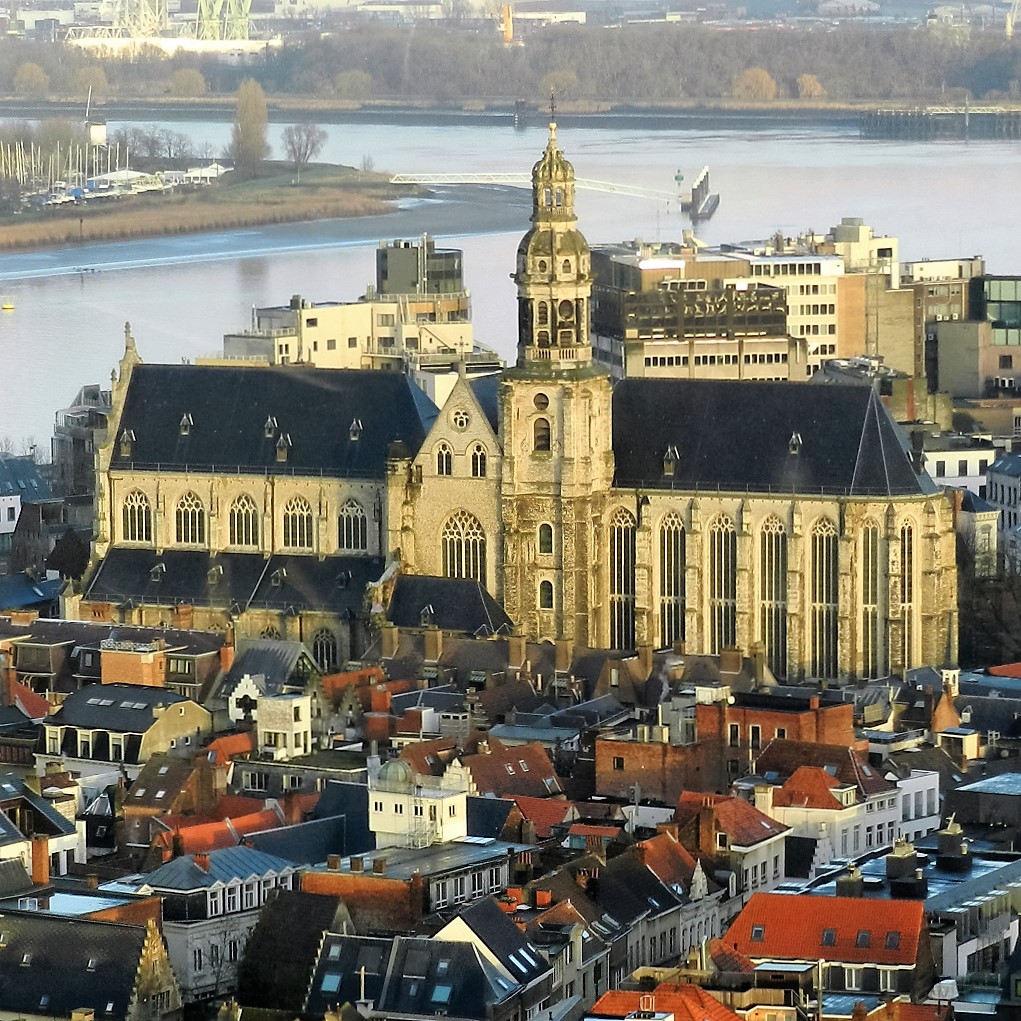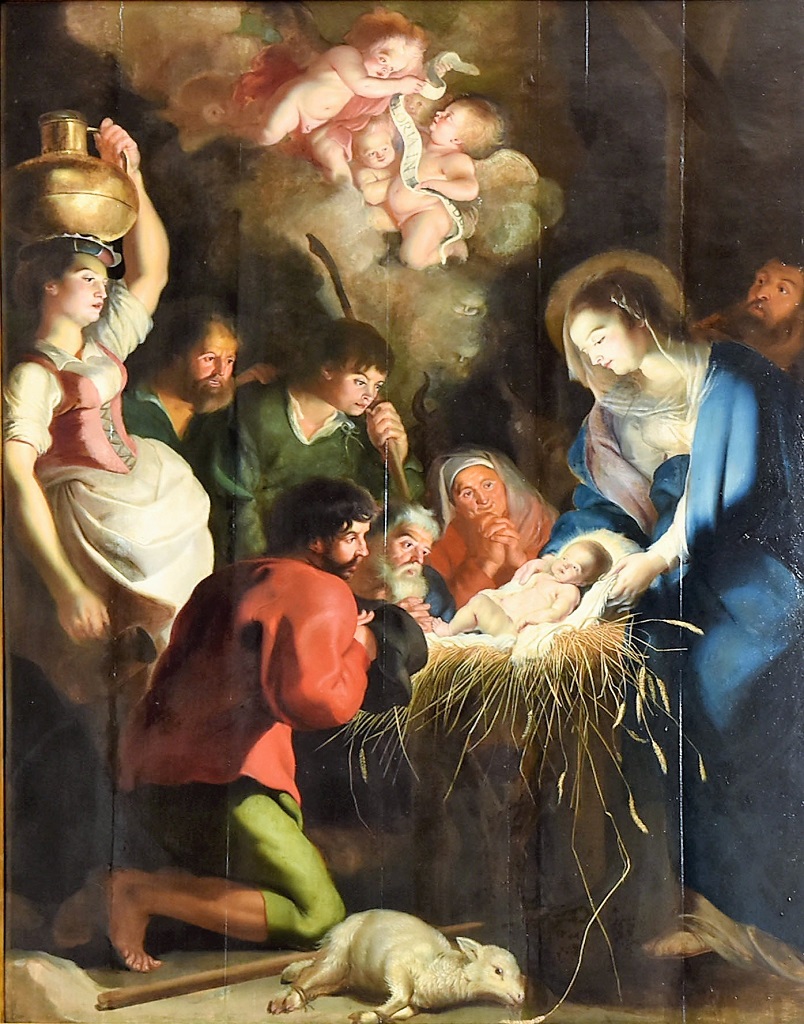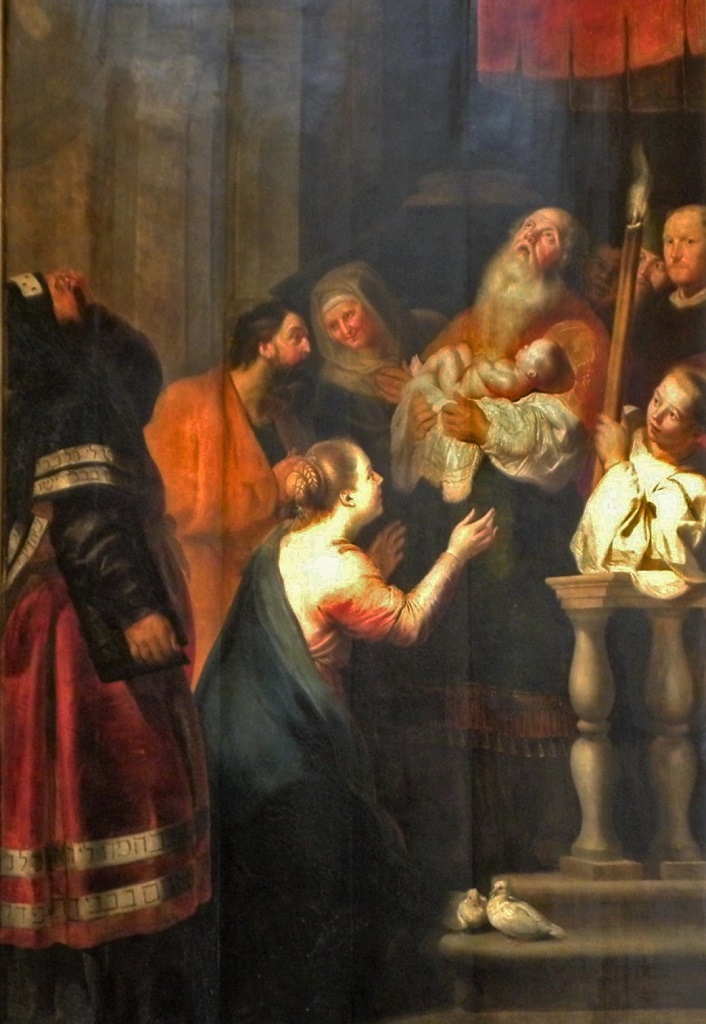Saint Paul’s, the Antwerp Dominican church, a revelation
The cycle of Paintings The Fifteen Mysteries of the Rosary
THE JOYFUL MYSTERIES
The first Joyful Mystery
THE ANNUNCIATION
(Hendrik Van Balen)
In the Baroque view the story of the Annunciation (according to Lk. 1:26-38) is not situated in a house but in an impressive palace. True to the gospelOne of the four books of the Bible that focus on Jesus’s actions and sayings, his death and resurrection. The four evangelists are Matthew, Mark, Luke, and John. ‘Gospel’ is the Old English translation of the Greek evangeleon, which literally means ‘Good News’. This term refers to the core message of these books. the angel Gabriel “comes to her” (1:28) to bring her the message that she has been favoured to be the mother of Jesus, “Son of God”. Mary “was greatly troubled at what was said” and turns around. That Mary is a woman of flesh and blood is symbolized by her red dress, while the blue cape she is enveloped in signifies she is a gifted woman and favoured by God (1:28-30). These colours contrast with those of the angel’s: yellow and green. Real surprise is not to be seen in Mary’s face; both figures are too doll-like and lack every possible expression of emotion.
In a blessing gesture God the FatherPriest who is a member of a religious order. has the Holy SpiritThe active power of God in people. It inspires people to make God present in the world. Jesus was ‘filled with the Holy Spirit’ and thus showed in his speech and actions what God is like. People who allow the Holy Spirit to work in them also speak and act like God and Jesus at those moments. See also ‘Pentecost’. “come upon” Mary (1:35), traditionally in the shape of white dove exhaling a bright white halo. Full of joy the angels in Heaven witness the mystery of Jesus’ incarnation. Two angels pay tribute to Mary with roses.
The second Joyful Mystery
MARY VISITING ELISABETH
(Frans II Francken)
This is one of the very few larger works by Frans II Francken, who was deanPriest – usually a parish priest himself – who coordinates the work of several neighbouring parishes [a deanery]. of SaintThis is a title that the Church bestows on a deceased person who has lived a particularly righteous and faithful life. In the Roman Catholic and Orthodox Church, saints may be venerated (not worshipped). Several saints are also martyrs. Luke’s Guild in 1616. True to the Bible (Lk. 1:39) the fantasized landscape illustrates Mary’s voyage “to the hill country”, on her way to her older cousin Elisabeth, who is also pregnant. As she is “most blessedUsed of a person who has been beatified. Beatification precedes canonisation and means likewise that the Church recognises that this deceased person has lived a particularly righteous and faithful life. Like a saint, he/she may be venerated (not worshipped). Some beatified people are never canonised, usually because they have only a local significance. among women” (1:42) it is clear that Mary is the central figure. We can see her in the foreground as she lays her hand on that of her older cousin in greeting (40b). By humbly putting her hand on her chest Elisabeth says: “how does this happen to me, that the mother of my Lord should come to me?” (1:43). The bunch of keys and the purse Elisabeth is wearing, illustrate that the ‘housekeeping’ the lady of the house was responsible for, could be seen literally as ‘economics’ or house management in the 17th century.
Discretely, more in the background, both husbands embrace. As he is a minister of the Temple Zechariah is wearing a cope, which Francken borrows from contemporary Catholic liturgy.
A bit closer to the right, two angels with elegant colourful wings, follow with the luggage. They are carrying it and have a vivid conversation.
Extremely true to nature big trees and animals have been made small in the background and small insects have been rendered big and exceptionally detailed in the foreground. Through the transparent upper wings of the dragonfly one can see the upper step in front of the house, through the lower wings we can see its shadowy side. In the middle distance the elegant silhouette of a pair of swans is reflected in the water. In the background little rabbits play in an open field in the woods: a peaceful scene, which is being watched by deer that dare leave the shelter of the forest for a while. It can certainly be questioned whether every detail in the landscape has to be considered in a symbolic way.
The third Joyful Mystery
THE NATIVITY
(Cornelis de Vos)
In a wooden stable (top right corner) to the extreme right, next to the frame, there is Mary (M).
Mary has only eyes for her newborn Baby and has already unwrapped the cloths from the Child to show Him proudly to the shepherds.
The child Jesus (+) in a crib looks at the visitors before Him. Behind Mary is loyal Joseph (Jo), modestly in the dark background. Due to his doubt about the true nature of this birth, his attention goes to the little angels (E), who hold a banderol with the scriptural passage: “GLORIA IN E[xelci]S DE[o]”.
As Mary’s counterpart there is a shepherdess (♀2) with a brass milk pitcher on her head and a jug in her right hand.
The kneeling shepherd (♂1) on the foreground, his hat in his hands, the staff on the ground, has laid down a tied little lamb as a present. Other ones keep their hands joined in prayer. Jacob Van der Sanden (ca. 1781), who was attached to the academy of art, saw “Genuine joy on the faces”. This painting is the one of the series that fascinates most, thanks to the vigorous colour. The way the light succeeds in differentiating the colours and at the same time freshen them up, is just sublime: a strongly Caravaggio-like lighting, inspired by Rubens’ painting of the same name in the Northern transeptThe transept forms, as it were, the crossbeam of the cruciform floor plan. The transept consists of two semi transepts, each of which protrudes from the nave on the left and right.. This warm range of colouring is due to the yellow of the ears of wheat in the crib and the brass milk pitcher, the brightly red short jacket and the light green knee breeches of the kneeling shepherd, and Mary’s blue cloak. Moreover the blue has been symbolically combined with her white garments and her white complexion.
In a subtle way the newborn Saviour radiates spiritual light. The white circle, consisting of the unfolded cloths and the aureole, amplifies the Child as the source of light in the painting. Jesus, “the light of the world” (John 8:12) that “shines in the darkness” (John 1:4), is represented pictorially in the way the Child makes the faces and the visible members of the people present brighten. Van der Sanden: “In this ChristmasThe feast commemorating the birth of Jesus. It is always celebrated on December 25. night Cornelis de Vos has cleverly had all light come from the representation of the born Messiah, as the divine Light in the darkness of the peoples.”
What are pastoral motifs at first sight, turn out to be bearers of ‘hidden’ symbolism. The little lamb of which the feet have been tied, is more than just a present from the shepherds. It symbolizes the final meaning of Christ as the sacrificed ‘Lamb of God’, a name that is also given to the hostA portion of bread made of unleavened wheat flour that, according to Roman Catholic belief, becomes the body of Christ during the Eucharist. in the EucharistThis is the ritual that is the kernel of Mass, recalling what Jesus did the day before he died on the cross. On the evening of that day, Jesus celebrated the Jewish Passover with his disciples. After the meal, he took bread, broke it and gave it to his disciples, saying, “Take and eat. This is my body.” Then he took the cup of wine, gave it to his disciples and said, “Drink from this. This is my blood.” Then Jesus said, “Do this in remembrance of me.” During the Eucharist, the priest repeats these words while breaking bread [in the form of a host] and holding up the chalice with wine. Through the connection between the broken bread and the “broken” Jesus on the cross, Jesus becomes tangibly present. At the same time, this event reminds us of the mission of every Christian: to be “broken bread” from which others can live.. All the same as in Rubens’ Nativity the ears of wheat in the crib refer to the Heavenly ‘bread from heaven’.
The donor was Miss Magdalena van Wissekercke (1593-1679), who since 1615 had been associated with the Jesuits as a spiritual daughterAn unmarried woman who only took the (temporary) vow of purity and placed herself under the spiritual guidance of a priest, usually a Jesuit, to lead a thoroughly spiritual life. They lived in their own houses in the city, sometimes together with relatives. In our regions, this was the Jesuits’ response to the fact that they had no female order. In Protestant areas, where monasteries had been abolished, this was a way out for women who aspired to a monastic life.. Her memorial slab in the cellar corridor of Saint Charles Borromeo Church is still intact.
The fourth Joyful Mystery
THE PRESENTATION (OF JESUS) IN THE TEMPLE
(Cornelis De Vos)
True to Jewish religious prescriptions Mary comes to the Temple of Jerusalem on the fortieth day after her child’s birth to be ritually cleansed (‘Purification’) and to consecrate her first born son to God (‘Presentation’), according to Lk. 2:22-39. Because the priestIn the Roman Catholic Church, the priest is an unmarried man ordained as a priest by the bishop, which gives him the right to administer the six other sacraments: baptism, confirmation, confession, Eucharist, marriage, and the anointing of the sick. is at the same time the devout, old Simeon, who was “awaiting the consolation of Israel” (v. 25), his gaze reflects the gratefulness for his eyes had seen God’s “salvation, which” He had “prepared in sight of all the peoples” (vv. 30-31). His liturgical garments were highly imaginatively inspired by contemporary Catholic vestments. How playfully do the looks of the characters reflect the direction of this presentation!
Mary, on her knees at the bottom of the steps, keeps looking up motherly at her Child in Simeon’s arms. The latter holds his head backward, his eyes towards Heaven, which stresses the movement of the typically Baroque diagonal composition.
A young acolyteAn altar server of 16 years of age or older., in a white surpliceA long-sleeved, half-length white robe worn over a cassock. Rochet is a synonym., carries a burning candle. Referring to the Catholic liturgy of CandlemasOn February 2 – i.e. on the fortieth day starting with Christmas – it is commemorated that Joseph and Mary, Jesus’s parents – dedicated their first born son to God in the Temple of Jerusalem – the so-called Presentation. This also went with a purification rite for the mother (Mary). Traditionally candles are consecrated and burned on that day – hence the name. This feast closes the Christmas tide., this illustrates Simeon’s words of joy, namely that his eyes have seen “a light for revelation to the Gentiles” (v. 32).
The couple of white turtledoves – the offering of the poorer Jews – make a peaceful still life, free and unconstrained, the heads close to each other. The second part of the story (vv. 36-39) is situated in the background, where the 84 year old prophetess Hanna starts a conversation with Joseph.
However much the distinguished Jewish scribe, on the left, exerts himself to look at the child through his spectacles, he cannot overcome the disability of his short-sightedness. As long as he takes ‘a Jewish view’ of things, he will not be able to recognize the long-awaited Saviour. The Hebrew strips of text on the sleeves and the bottom of his cope refer to the law of the first born being dedicated to God. On the top of his sleeve there is “Consecrate to Me every first-born” and on the bottom edge “all the first-born in Israel”. On the top edge of his cope’s seam there is: “I made sacred to Me, both of man and of beast” and on the bottom edge: “Every first-born son you must redeem” (Ex. 13:13).
This distinguished Jew represents Judaism (the Synagogue); the Dominican on the extreme right against the frame, whether by coincidence or not at Jesus’ right hand side, and the acolyte represent the Church, or Christianity. The Dominican with the Baroque interactive gaze towards the spectators is thought to have been Father Boucquetius, a great promoter of the rosary devotion and possibly the commissioner of the whole series.
Because this is the only panel of which the way of financing has not been noted down, it is supposed to have been a gift by the painter himself.
The fifth Joyful Mystery
THE FINDING OF JESUS IN THE TEMPLE
(Matthys Voet)
While their twelve year old son is teaching amidst the scribes in the Temple of Jerusalem, Mary and Joseph find him, according to Lk. 2:42-50.
The twelve year old Jesus adducing arguments (with His right forefinger), sitting on an elegant chair under a baldachin, alludes to the wise King(-judge) Solomon.
Challenged by his questions the Jewish scribes look for arguments in the Biblical books and scrolls (the Old TestamentPart of the Bible with texts from before the birth of Jesus.). Right in front of Jesus one of them is arguing, keeping his right forefinger to his upright left thumb. Next to him another one puts up a book with a pseudo Hebrew text, while he is putting on his glasses to consult another book.
Also the two dwarfs below – a black one and in front of him a white one, attired in elegant headbands – want to argue along with the others.
The second part of the story, the actual finding, is paid less attention to. Young Mary looks at her child in an obviously worried way, thus expressing her “great anxiety” (v. 48). Behind her we can notice the older face of Joseph, he too fixing his gaze upon Jesus. It is remarkable how Mother and Child nearly merge due to the colours of their clothing.

The scientific justification of the data concerning the Mysteries of the Rosary in Saint Paul’s in Antwerp can be found HERE.
It is basically written in Dutch, but using the translate button you can ask for an instant translation in English





